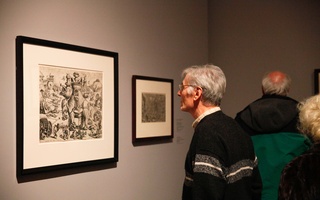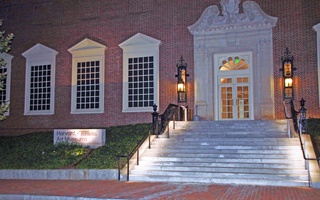{shortcode-f7a51faadad6b0930db2026d5fafcaa964798e47}In each of Andy Warhol’s silkscreen prints of Marilyn Monroe, the vivid colors encapsulate the multifaceted personality of the actual person behind the famous face. After creating the iconic Marilyn face shortly after her death in 1962, Warhol revisited the piece again in 1967, creating a portfolio of ten silkscreen prints in varying hues. Every Monday between Sept. 11 and Oct. 2, the Harvard Art Museums are displaying six of the ten Marilyn screen prints.
At the Art Study Center, visitors can request to see any of the museum’s collection of 249,000 of works of art. Viewing the Marilyn Monroe prints as a group proves to be a unique way to interpret them, according to Mary Schneider Enriquez, Houghton Associate Curator of Modern and Contemporary Art.
“He makes her face into something that we see in different ways, in different colors, and because we are able to see so many versions together. We get to see her as someone that is more than a mask and popular image” she said. “I wasn’t able to see this until they were all side by side.”
This collection is a special event at the museum’s Art Study Center, which holds open hours each Monday afternoon. Mary Lister, manager of the Art Study Center, said that she anticipates other interesting programs to come after the Warhol collection. “Sometimes we connect it to a gallery talk[...], where the curatorial colleagues will ask to have specific works up in the space that connect to their theme,” she said.
{shortcode-afee7640a7b0b9c141b0413f2b82a15cdf43b879}The showing of Warhol’s pieces at the Study Center is timed to coincide with the American Repertory Theatre’s upcoming show, WARHOLCAPOTE. Unbeknownst to many, Warhol and Capote were great friends, and they recorded a series of conversations over the course of two months in the late 1970’s. The A.R.T. is also opening itself up to collaboration with the museums, hosting a talk after the show. Schneider Enriquez, who will be speaking at the talk, said it’s crucial for the two to have an open dialogue about the practice of creating art and performing in the past and present.
Schneider Enriquez said that she sees the programs as ways to explore connections between visual art and performance. “In many ways, Andy was a performer. He presented himself in a certain way for years and years [and] had many followers. But he also was an artist,” she said. “Having this topic is the perfect opportunity to think about Warhol’s presence in 20th century art.”
—Staff writer Nicole T. Sturgis can be reached at nicole.sturgis@thecrimson.com.
Read more in Arts
“Half-Light” is the Best of Rostam’s SensibilitiesRecommended Articles
-
 ‘Triangle Constellation’ Celebrates Harvard Art Museums’ Expansion
‘Triangle Constellation’ Celebrates Harvard Art Museums’ Expansion -
 Koerner Ventures Beyond Bosch at Harvard Art Museums
Koerner Ventures Beyond Bosch at Harvard Art Museums -
Doris Salcedo Commemorates Colombian Victims in New ExhibitionDespite the international acclaim her sculptures receive for their sociopolitical implications, Doris Salcedo identifies solely as a maker of art. “I am an artist,” she said at the press preview of her new exhibition at the Harvard Art Museums. “I am not a political activist; I am not in social justice. I am an artist: That’s all I am and all I want to do.”
-
Art Museums Launch Fellowship, Summer Institute Through DonationsThe Harvard Art Museums received over $1.5 million in donations this month for a new fellowship and summer program.
-
 Art Rental Program Lowers Fees, Draws Students
Art Rental Program Lowers Fees, Draws Students













